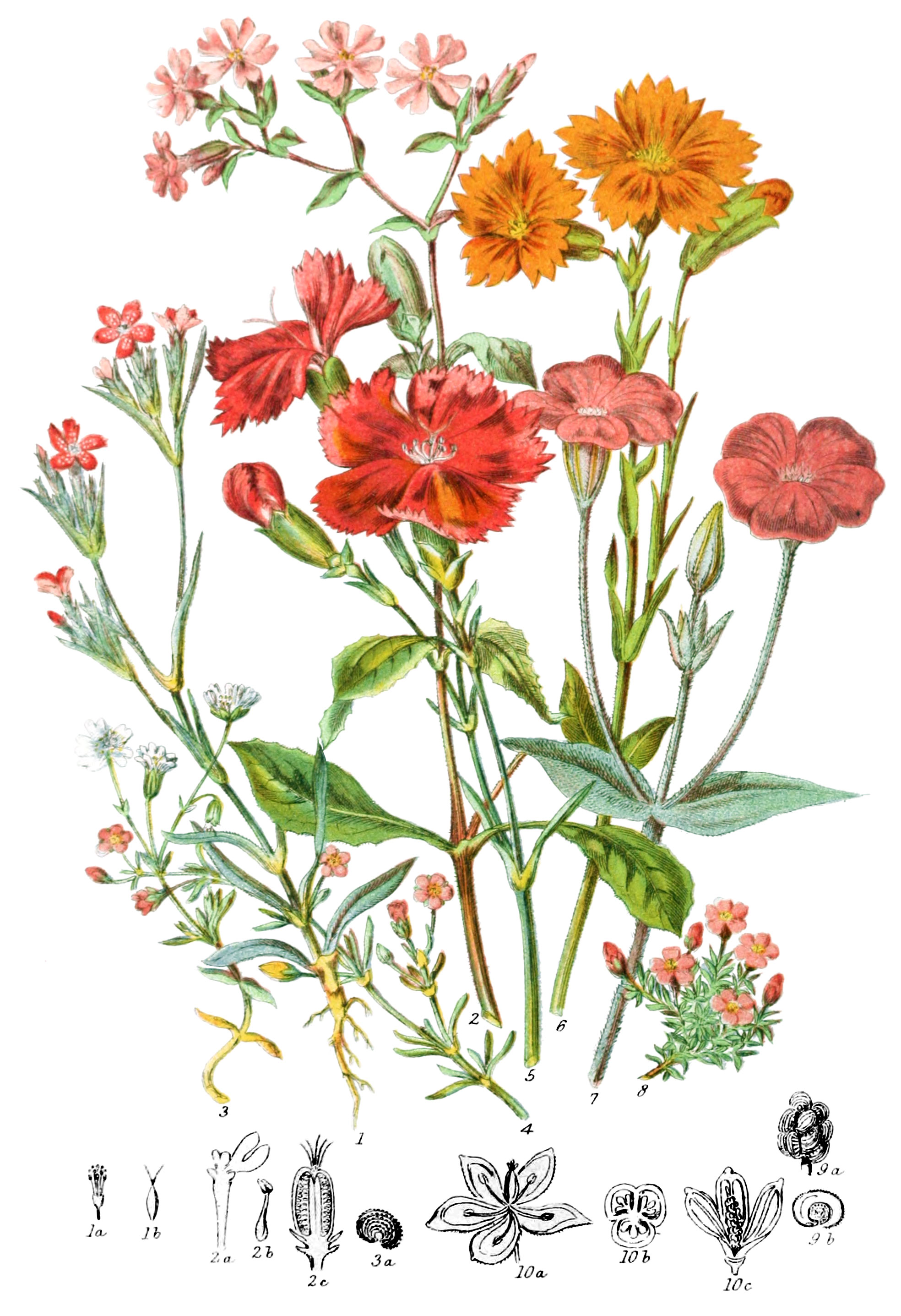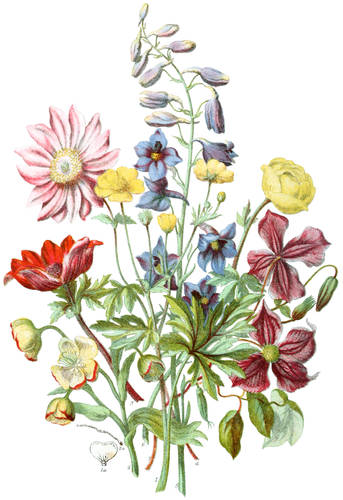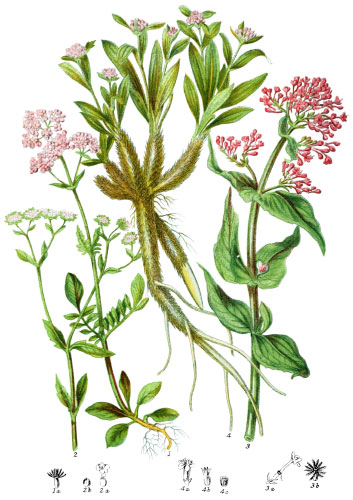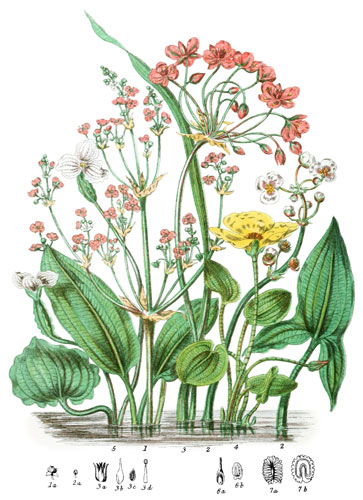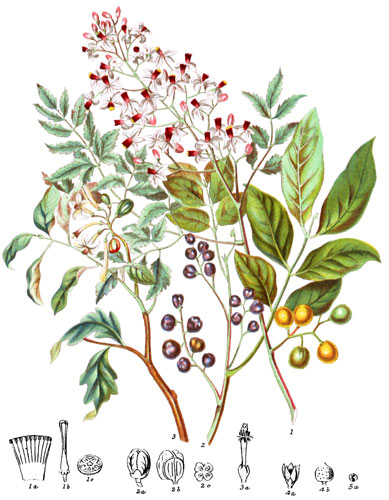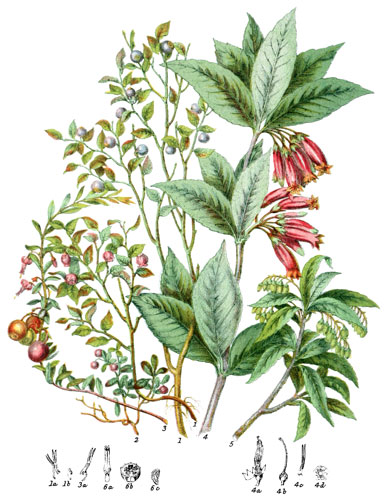Key characteristics
Herbaceous plants, occasionally becoming partly shrubby at the base; the stems are enlarged at the joins. The leaves are always opposite, often united at their base, entire at the edges. The calyx has four or five sepals continuous with the flower-stalk, persistent, distinct, or cohering in a tube. The petals are four or five inserted upon the short stalk of the ovary, frequently deeply cleft, often having scales, which form a crown at the top of the tube: occasionally the petals are wanting, as in Mollugo (10).* The stamens are usually twice as many as the petals; the filaments are sometimes united in a set, awl-shaped, the anthers fixed on the point, two-celled, opening longitudinally. The ovary is composed of from two to five carpels, and is placed on a small stalk; the stigmas are from two to five, thread-like, rough on the inner edge, the ovules few or many. The capsule is from two to five-celled, with a cental plate either free in the one-celled capsule, or adhering slightly to the edges of the valves in the five-celled capsules. The seeds are indefinite, rarely few, kidney-shaped, having a crustaceous exterior, and mealy albumen within.
These plants have some affinity with the Saxifrage tribe, and resemble the Portulaceæ in may points.
Insipidity is their chief character; a few are saponaceous.
Select plants in this order
Not all plants listed are illustrated and not all plants illustrated are listed.
- Although it is to this Tribe that we are indebted for the clove-pink with all its varieties of Carnation and Picotee, and othe flowers which have long been prized as ornaments of gardens, yet the principal portion of the plants are of small size and insignificant aspect.
- Dianthus was so named by the Greeks on account of its extreme fragrance and beauty.
- D. armeria (1) is the most common of our pinks, found in various places in England, chiefly on a gravel soil; it is supposed to be the origin of many kinds of garden Pinks, the cultivation of which affords peculiar interest to some classes of persons who are deprived of much space of ground; the manufacturers of Paisley and other towns delight in raising the different varieties.
- D. caryophyllus (5) is occasionally seen on old walls, as on those of Norwich, Rochester Castle, and elsewhere. In the wild state, the petals are small and of a pale pink; throughout Eruope it is much esteemed for its delicious fragrance, and is a general favourite in the formal flower-beds of the Dutch, and the more luxuriant gardens of the Italians. The leaf has been found to contain on each surface 38,500 pores in a square inch.
- D. deltoides is found in grassy pastures about Blair Athol and other parts of Scotland.
- D. cæsius is the rare Mountain-Pink, confined to the Cheddar cliffs in this country, but dispersed in favourable locaclities in Switzerland and Germany.
- D. barbatus, the Sweet William, is one of the oldest inhabitants of our flower-gardens, brought from the South of Germany.
- D. superbus is an elegant species, having the petals numerously and finely divided, a native of the South of France and the wide valleys of the Pyrenees.
- Lychnis affords a few bright-coloured flowers from Russia and other countries; several species also adorn our fields and hedges, one of the most abundant is L. diurna (2), which continues to blossom late into the autumn.
- Some kinds of Lychnis and Silene have glutinous hairs, which entangle flies and small insects, whence their common name of Catch-fly.
- Silene acaulis (8) belongs to that portion of the tribe which thrives best in Alpine situations, on the Scotch and Swiss mountains it grows in close tufts, the bright rosy flowers shining amidst the slender leaves.
- S. inflata and S. viscosa, of England and Siberia, are found also on the Himalayas.
- S. cisplatensis grows on the sands of the sea-shore near Monte Video, Brazil, the calyx clothed with long hairs.
- Agrostemma, “the crown of the field,” deserves its appellation; our common corn-cockle is hardly surpassed by A. coronaria (7) of Italy.
- Cerastium (3) is common in Europe and other parts of the world, bearing small white, star-shaped flowers.
- C. rivulare is a native of river-shores of Brazil.
- Arenaria marina (4) is frequent on our sandy coasts; the fleshy leaves have membranous stipules sheathing their base.
- A. peploides, of Britain, belongs to Iceland, and is valued by the poor pesants as wholesome food, after being steeped in sour whey till it ferments.
- A. verna is also in Madeira.
- Stellaria media, Chickweed (9),† is well known as the common food of small birds, who find a suitable provision in the mealy albumen of the seeds. This humble little plant is widely scattered over the earth, being very general in Europe, springing up on the plains of India during the cold season, and seen by the wayward near cities in Brazil.
- Spergula arvensis yields nourishing food to sheep.
- Saponaria officinalis contains Saponine, as does Gysophila Struthium, the Soap-root of Egypt, and a few other species.
- Mollugo glinoides (10)* flourishes on the sandy banks of the river Uruguay, in Rio Janeiro.
Locations
This Tribe is found in the Temperate and cold regions of the globe, in various localities; in the Tropics, on lofty mountains; on the Alps, ascending to the limits of perpetual snow; on the plains of Lapland, forming a considerable portion of the vegetation. Mollugo is the most tropical genus.
Legend
- Dianthus armeria, Deptford Pink. England.
- Stamens.
- Pistil.
- Lychnis diurna, Red Campion. England.
- Petal.
- Stamen.
- Section of Ovary.
- Cerastium arvense, Field Chick-weed. England.
- Seed.
- Arenaria marina, Sea Sand-wort. England.
- Dianthus aryophyllus, Clove-Pink. England.
- Lychnis Bungeana. Asiatic Russia.
- Agrostemma coronaria. Italy.
- Silene acaulis, Moss Campion. Britain.
-
- Stellaria media, Common Chickweed. Cluster of Seeds.
- Section of Seeds.
-
- Mollugo glinoides. Flower magnified.
- Section of Ovary.
- Seed-vessels.
- *10 was mentioned in the original description but only 10a, 10b, and 10c were illustrated.
- †9 was mentioned in the original description but only 9a and 9b were illustrated.
Explore more
Posters
Decorate your walls with colorful detailed posters based on Elizabeth Twining’s beautiful two-volume set from 1868.
Puzzles
Challenge yourself or someone else to assemble a puzzle of all 160 botanical illustrations.
